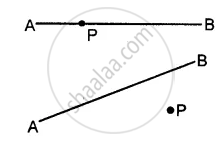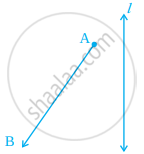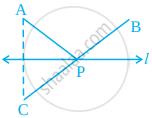Advertisements
Advertisements
Question
Draw an angle of 140° with the help of a protractor and bisect it using ruler and compasses.
Solution

Steps of construction:
(i) Draw ∠BAC = 140° with the help of protractor.
(ii) With A as centre and any convenient radius, draw an arc, cutting AC and AB at Q and P respectively.
(iii) With centre P and radius more than `1/2 (hat(PQ))`, draw an arc.
(iv) With centre Q and the same radius as before, draw another arc, cutting the previously drawn arc at a point S.
(v) Join AS and produce it to any point X. Then, ray AX bisects ∠CAB.
APPEARS IN
RELATED QUESTIONS
Draw a line segment PQ = 4.8 cm. Construct the perpendicular bisector of PQ.
In each of the following, draw perpendicular through point P to the line segment AB :
(i)

(ii)

(iii)

Draw a line segment of given length and construct a perpendicular bisector to line segment using scale and compass
8 cm
Draw the images of points A and B in line l of figure and name them as A’ and B’, respectively. Measure AB and A’B’. Are they equal?
In figure, the point C is the image of point A in line l and line segment BC intersects the line l at P.
(a) Is the image of P in line l the point P itself?
(b) Is PA = PC?
(c) Is PA + PB = PC + PB?
(d) Is P that point on line l from which the sum of the distances of points A and B is minimum?
Bisect ∠XYZ of figure.
Draw a line segment of length 10 cm. Divide it into four equal parts. Measure each of these parts.
Draw a line segment of length 12.8 cm. Using compasses, divide it into four equal parts. Verify by actual measurement.
With `overline"PQ"` of length 6.1 cm as diameter, draw a circle.
Draw any angle with vertex O. Take a point A on one of its arms and B on another such that OA = OB. Draw the perpendicular bisectors of `overline"OA"` and `overline"OB"`. Let them meet at P. Is PA = PB ?
